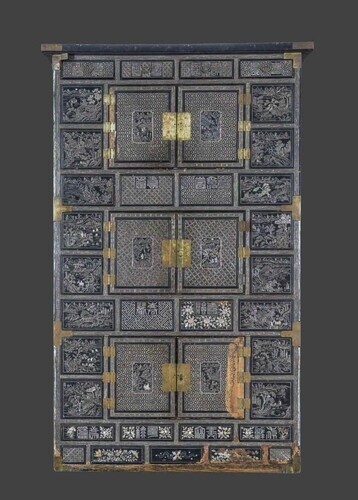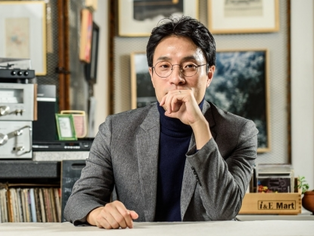 |
| ▲ This photo of the Najeon landscape three-tiered chest is provided by the Korea Heritage Service (KHS). (PHOTO NOT FOR SALE) (Yonhap) |
SEOUL, Sept. 25 (Yonhap) -- A traditional piece of furniture said to have been bestowed by King Gojong (r. 1863–1907) upon American missionary Henry Appenzeller (1858–1902) has been designated as a national folk cultural heritage, the Korea Heritage Service said Thursday.
The "Najeon Landscape-Pattern Three-Tier Cabinet," housed at the Paichai School History Museum in central Seoul, was crafted in the late 19th century. Najeon is a traditional Korean craft technique in which abalone or seashells are ground, cut into patterns and inlaid into wooden furniture coated with lacquer, producing an iridescent glow.
Measuring 114.9 cm in width, 54.6 cm in depth and 180.3 cm in height, the cabinet is decorated with landscape patterns and calligraphic motifs that combine painting and craft on its front and sides. The inner panels of its doors are also adorned with brightly colored paintings.
The cabinet had been preserved by the Appenzeller family, who founded Paichai School, before being donated to the museum in 2022 by Diane Dozier Crum, the great-granddaughter of Appenzeller through his second daughter, Ida.
The cabinet is considered highly valuable in its own right. Such three-tier cabinets were popular among the royal court and upper classes of the late Joseon period, often prepared as essential items for royal children upon marriage. This example reflects the styles used in the royal court and aristocracy in the late 19th century and shows influences from Tongyeong, a region known for its lacquerware and mother-of-pearl craftsmanship.
 |
| ▲ This photo of the interior of the Najeon landscape three-tiered chest is provided by the Korea Heritage Service (KHS). (PHOTO NOT FOR SALE) (Yonhap) |
An official from the heritage agency said the cabinet holds great value as a rare piece that illustrates ties between the imperial household of the Korean Empire and Western missionaries in the late 19th century.
The Korea Heritage Service also designated the Samtae Village Forest in Hago-ri, Gochang County, as a natural monument. The forest stretches for some 800 meters along the Samtae Stream in front of the village and has long protected the community from natural disasters as a windbreak.
Home to Korea’s largest colony of old willows, the forest includes 95 willow trees taller than 10 meters with trunks over 3 meters in circumference, alongside 224 trees of various species. The agency said villagers have regarded the grove as sacred, believing that harm to it would bring calamity, making it a significant natural heritage site embodying local faith and identity.
A ceremony marking the designation was held at the Samtae Village Hall at 2 p.m. on Thursday.
(C) Yonhap News Agency. All Rights Reserved

















![[2026 Outlook] BTS, BLACKPINK comebacks; UNESCO World Heritage session in Busan fuel K-culture momentum](https://korean-vibe.com/news/data/20251226/p1065576816972067_337_thum.jpg)





